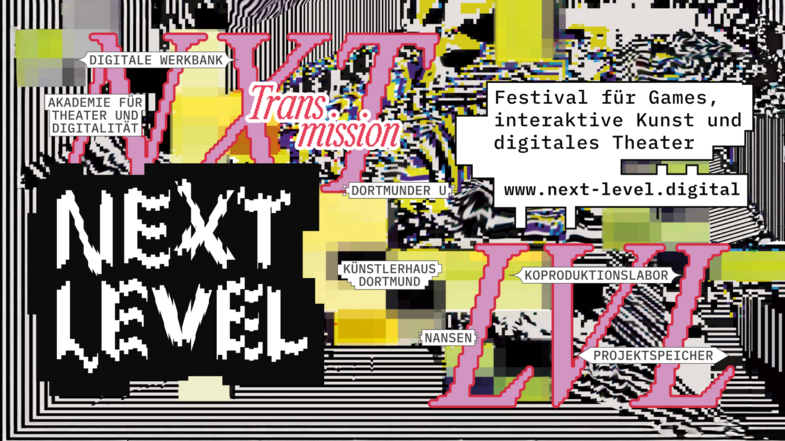
The NEXT LEVEL Festival in Dortmund is a place for everyone who wants to experience games and digital arts from a fresh perspective. It is about how games become creative expression, spark ideas, and open conversations about our digital present. The program combines exhibitions, performances, talks, and workshops into a versatile mix that inspires audiences to dive in and take part. International artists meet regional positions and local initiatives, and visitors become explorers themselves. Instead of providing ready-made answers, the festival invites questions, perspective shifts, and shared experiences that bring digital culture to life. For a few days, Dortmund becomes a meeting point for everyone who wants to be inspired by the energy of playfulness.
TRANSmission is the festival theme of NEXT LEVEL in Dortmund. It draws attention to the transitions that digital games make visible and tangible. Transmission means translation, transfer, transformation, all processes that shape our digital present. The festival asks how games as a medium reflect and reinterpret these processes: as an interface between body and avatar, as a bridge between cultures, or as a driver of technological innovation. Artistic works, installations, and discussion formats take up the theme and open pathways to urgent questions of our time. How are perception, communication, and community changing in the digital realm. What new possibilities emerge when we understand playfulness as a tool for exchange. With TRANSmission, the festival creates a framework in which digital games become a cultural practice that not only describes transitions but actively shapes them.
Supported by Theater Dortmund and its Academy for Theater and Digitality, the festival offers a highly networked, technically savvy, and interdisciplinary environment. In addition, numerous other pioneering institutions in the field of digital arts and innovation are involved as venues, including the Digitale Werkbank, the Dortmunder U, and the Künstlerhaus Dortmund.
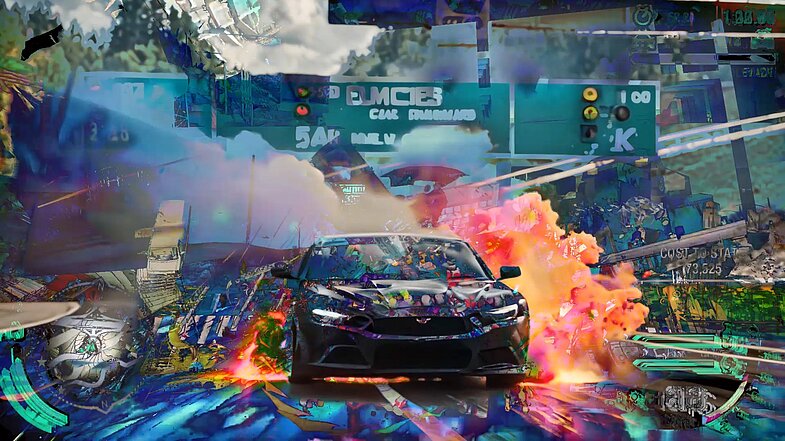
Violent Violins Exposed is an audiovisual installation that translates Babak Ahteshamipour’s album of the same name into an immersive environment. Built around three tracks, each accompanied by its own video, the work constructs fragmented universes that resonate with one another and conjure an atmosphere of darkness, violence, and unease. It probes the intersections of technological singularity, cybernetic warfare, and ecological collapse, entangling them with extractivist economies, the pursuit of capitalist immortality, and the promises of transhumanism. What emerges is a layered interplay of sound and image, where blackened dreams and despair become aesthetic tools to reflect on the forces shaping our accelerated present. The installation does more than visualize music – it opens a critical space where the fractures of a world driven by its own technologies are laid bare.
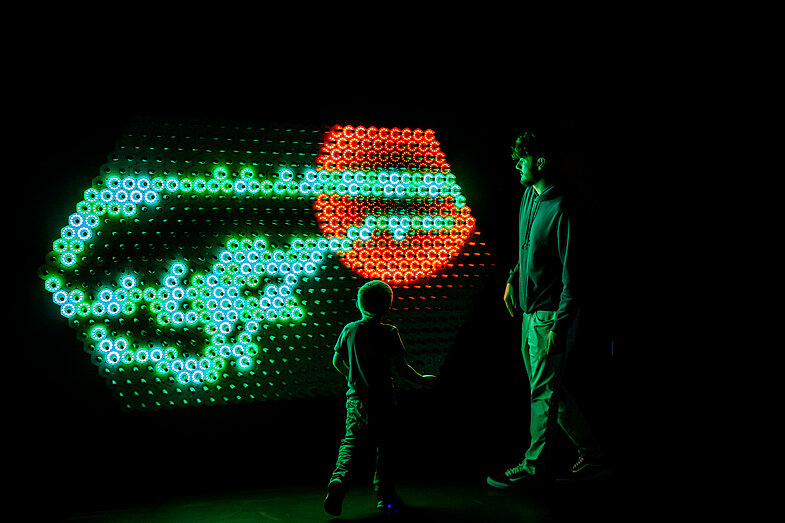
Quantum Jungle invites visitors to explore the abstract world of quantum physics with their hands. A vast wall covered with over a thousand touch-sensitive metal springs and countless LEDs responds to every touch, translating it into flowing movements of light. At its core lies Schrödinger’s Equation, modeling the behavior of a quantum particle. Through this, key concepts such as superposition, interference, wave-particle duality, and waveform collapse are made tangible.
Rather than portraying physics as complicated or remote, the installation turns it into a sensory and playful experience. Children and adults alike find themselves in a digital jungle that sparks curiosity, wonder, and an aesthetic encounter with science. Quantum Jungle demonstrates how transmission between science, art, and audiences can unfold: complex knowledge becomes immediate experience, inspiring reflection and connection.
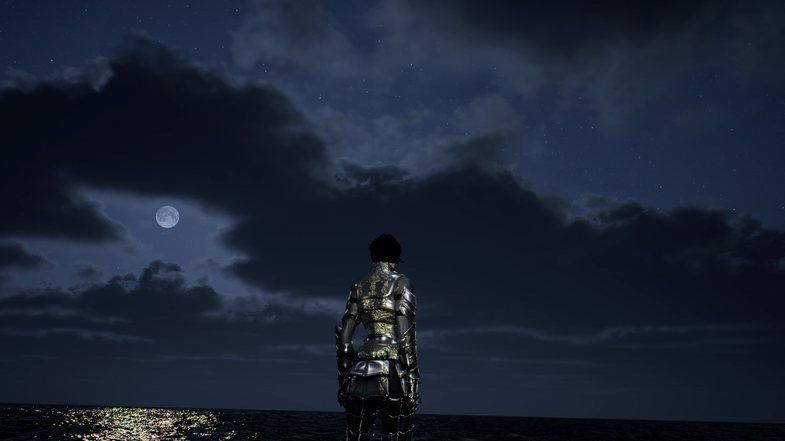
The Siren is a digital exploration that turns traditional game conventions inside out. It begins with a heroine clad in shining armor, guided by an omniscient narrator, seemingly on a mission to rescue someone in need. But before the quest unfolds, the player is tasked with collecting seashells: a side quest that expands and reframes the journey. The narrator’s voice grows insistent, increasingly authoritarian, raising the question: why do we obey? And what happens if we stop? The work mirrors the endless side quests of gaming culture while pointing toward our own lives, filled with tasks and rituals we invent to keep meaning alive. At the same time, The Siren examines the narrative of romantic salvation, the belief that love or the “other half” might shield us from life’s absurdity. The game offers multiple paths, yet no definitive conclusion, the “good ending” is elusive. As an installation, it combines accessible gameplay with contemplative cinematics, offering both players and viewers a rich experience. Rather than aiming for victory, The Siren invites drifting, reflecting on what it means to continue when the quest itself no longer seems to make sense.
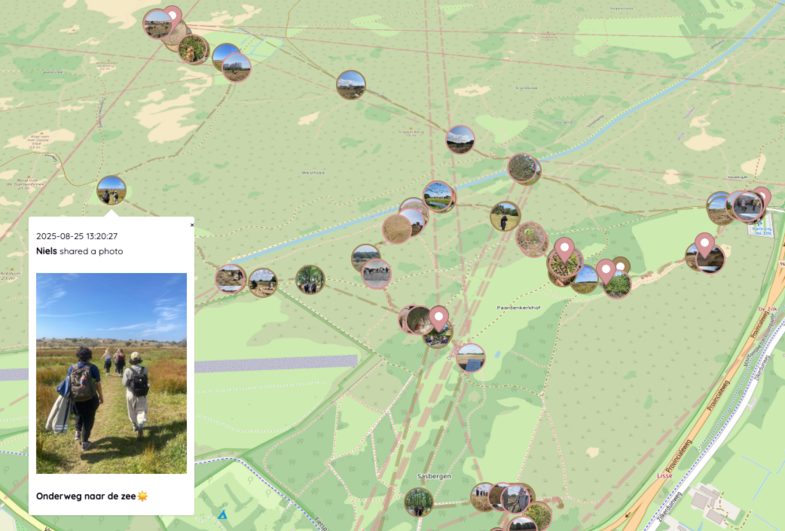
How is Dortmund’s urban environment designed for non-human life? What species live alongside us, and what measures could make the city more welcoming—or not? These questions shape the Walkshop around the Dortmunder U, where participants explore the area as a shared ecosystem. In small groups, they use digital tools to collect data with their phones: capturing photos, videos, audio snippets, interviews, and observations of urban wildlife and their habitats. Each group then creates a “data story,” blending hard facts such as sightings, locations, or recordings with soft impressions, emotions, and ecological reflections. The Walkshop invites participants to reimagine the city as a co-inhabited space and to use digital storytelling as a means of making more-than-human perspectives visible.
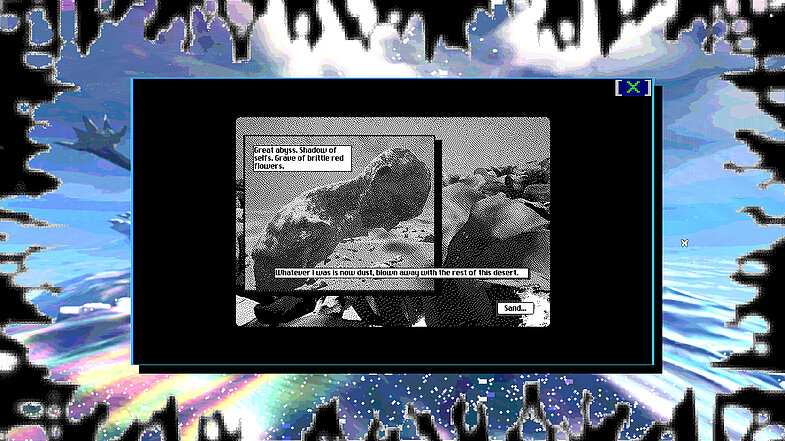
BlueSuburbia is an interactive literary project that first appeared online in 1999 and quickly became a cult favorite. As one of the defining pieces of net art of its era, it combined poetry with animated environments, guiding visitors through dreamlike, haunted landscapes. The Flash site continued to grow until 2005, when the death of Flash silenced it. Now reimagined, BlueSuburbia once again invites audiences to wander through poems as if they were places to be explored. Its tone hovers between beauty and terror, evoking both resilience and vulnerability in a world intent on destruction. It is an experience where players confront demons, navigate impending darkness, yet follow an inner light that refuses to let them surrender. BlueSuburbia is at once an intimate reflection and an immersive journey, a “beautiful horror” that carries its history from the early internet into the present.
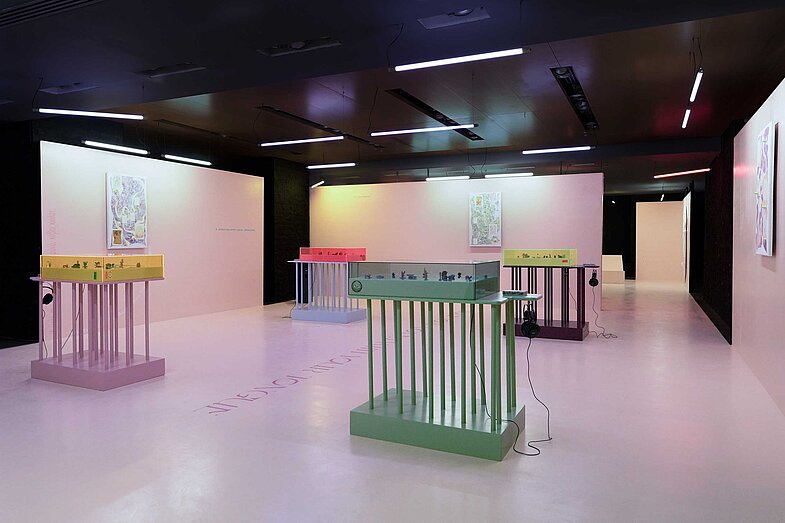
The Lived Necrologue was originally conceived for the 7th Athens Biennale and has transformed into something entirely new for this presentation. The installation operates as a living document of artistic memory, where the outdated overlaps with the urgent and contemporary, resembling archaeological layers of collective consciousness. At its core lie two intuitive gameboards by OMSK Social Club in collaboration with Jonas Schoeneberg’s tarot deck. Cards such as The Hedonic Eye or The Avatar grant access to the practice of “Real Game Play”, where viewers are not mere observers but co-authors of unfolding narratives. Each choice generates new possibilities while closing others, creating liminal zones, ambiguous threats, and transformative openings. Schoeneberg’s “informational paintings” weave historical references, personal symbology, and materials charged with temporal and celestial energies – from moonlight pigments to mineral vibrations. His tarot-inspired gaming cards guide viewers into interpretative pathways that blur personal memory with collective imagery. The sonic dimension, composed by Happy New Tears, moves between euphoria and grief, waking and dreaming, informed by experiences of in-betweenness. These “sonic protagonists” activate the space and invite emotional entanglement. The installation unfolds as both social sculpture and social painting, where images, games, and bodies intertwine. The Lived Necrologue ultimately asks what it means to hold agency within artistic, spiritual, and social systems, creating spaces where instability itself becomes an invitation to imagine new meanings.
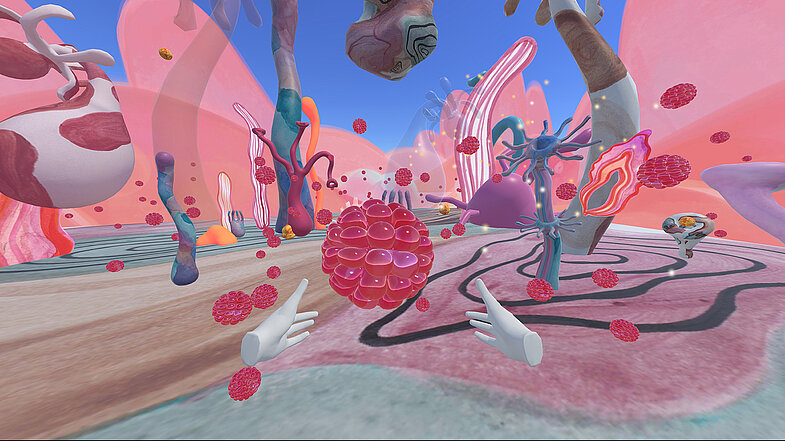
Cathex is an interactive VR experience that unfolds more like a poem than a game. Drawing from Mary Whiton Calkins’ philosophy of the universe as the “absolute self,” the work immerses participants in a digital landscape that feels at once nurturing and uncanny, like a subconscious given form. Within this environment, players explore the theory of cathexis – the emotional energies we invest in people, ideas, and experiences. The journey is shaped not by scripted sequences but by emotion-regulatory movements, turning every gesture into part of the unfolding narrative. As participants navigate through shifting emotional states, forgotten memories begin to surface, weaving together personal history and universal reflection. Cathex becomes a space of catharsis where players are not just witnesses but catalysts of their own story – an inward journey that simultaneously gestures outward toward the vastness of existence.
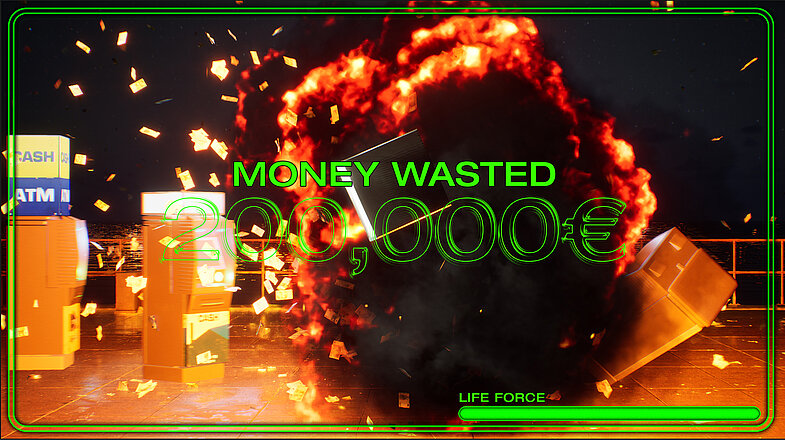
Token Eater and Wasted form a digital diptych that plays out the darker sides of consumer culture. Token Eater mimics the mechanics of a carnival claw machine, except that instead of plush toys, we catch fragments of e-waste. Each move yields symbolic money, while the bin magically replenishes itself with junk, pointing to the inexhaustible circulation of our consumption’s leftovers. Wasted, in contrast, places us on a solitary platform at sea where faceless ATMs roam like bumper cars. As players, we attempt to ram them before they hit us, collecting cash for every knockdown, yet the outcome is almost inevitably failure: falling into the water, being smashed by another machine, or stopped by the police. Both games expose the mechanics of gain and loss, abundance and depletion, by turning them into absurd yet familiar play loops. They offer a commentary on endless cycles of production and destruction, where even digital bodies become part of a system that never fully allows anything to disappear.
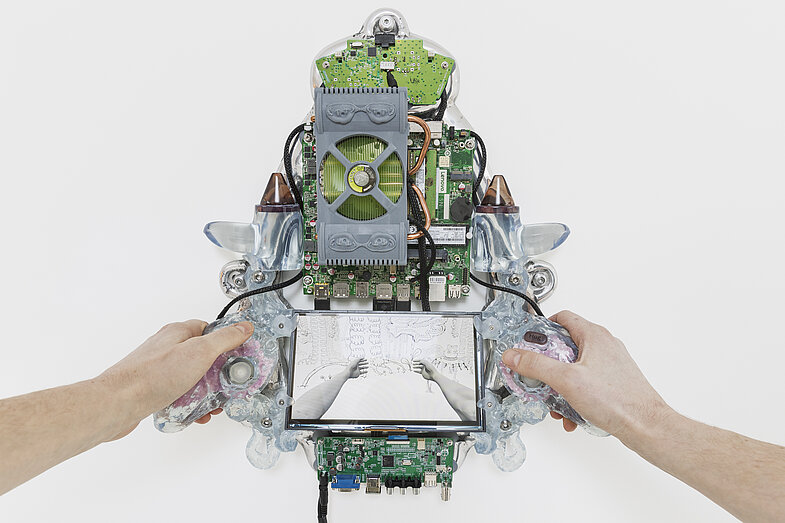
Wall Flower is an interactive sculpture built from a case-modded Windows 10 computer and custom-designed interface elements. It hosts the game “First Person Hugger,” where players wander through a world inhabited by hand-drawn fantasy characters. At the center of interaction is a single button labeled “Hug,” allowing players to embrace objects and characters within the game. The work responds to the dominance of the first-person shooter genre, defined by the perspective of a weapon’s sight, and proposes a new genre: the “first-person hugger.” Here, the digital world is experienced not through the lens of violence but through the perspective of open arms. Wall Flower thus becomes sculpture, gaming device, and statement at once – an invitation to occupy virtual worlds with affection instead of aggression.
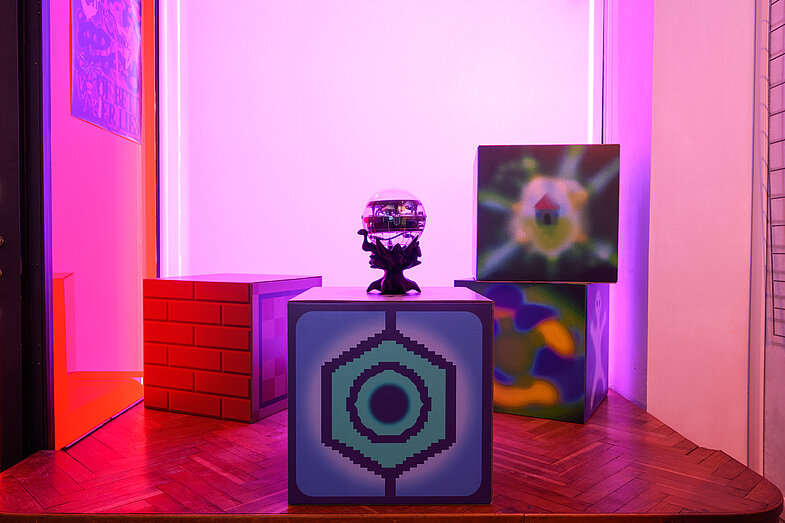
“The Core by Dorijan Šiško is a video game in which players navigate through an abstract labyrinth that articulates various notions relating to the visual imaginaries of the future. The players enter the game through a speculative interface resembling a crystal ball, with which they try to steer their way to the looming core of the maze. The path presents the players with crossroads that lead to different accelerationist routes towards divergent visions of potential worlds to come. Grappling the uncertainty of what lies ahead, players must make choices that determine the course of their journey as alternative paths emerge to create new trajectories to futurity predicated on past decisions. When, and if, the players finally reach the core, the idea of a pursued future becomes demystified, unveiled as a mere representation awaiting the conclusion of an imaginary journey.” (Maja Burja)
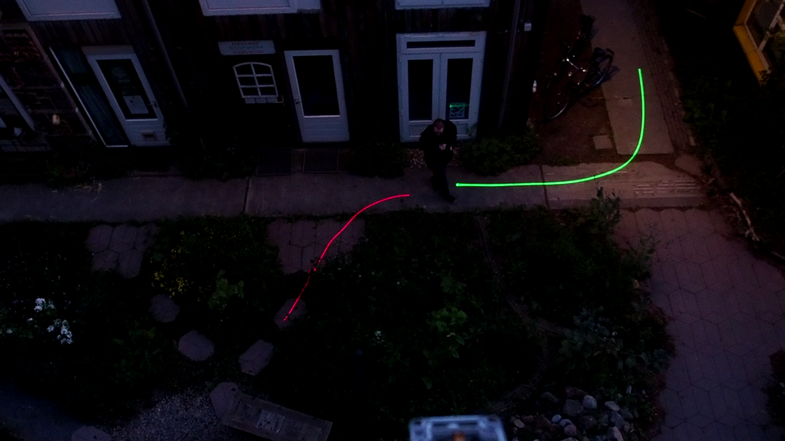
In train stations, shopping malls or city centres, camera surveillance has become omnipresent. Increasingly, such systems rely on AI-driven algorithms to identify supposedly “deviant behaviour.” But what does deviance mean when defined by algorithms? Perplexity explores this shift through a setup of surveillance camera, computer and laser projectors. The system continuously trains itself on the movements of people passing through the space, predicts their most likely paths and projects these as glowing traces right in front of their feet. The logic is reversed: rather than detecting anomalies, normality is simulated. Deviation occurs when reality no longer matches prediction. Thus, the algorithm’s error becomes a measure of suspicion. Perplexity makes visible how routine movements shape the backdrop of public life against which anomalies stand out. By confronting visitors with the predictability of their own paths, the installation invites them to disrupt their routines and reflect on the relationship between watcher and watched. Presented at NEXT LEVEL, Perplexity offers an artistic reflection on surveillance, simulation and the hidden influence of algorithms on our everyday trajectories.
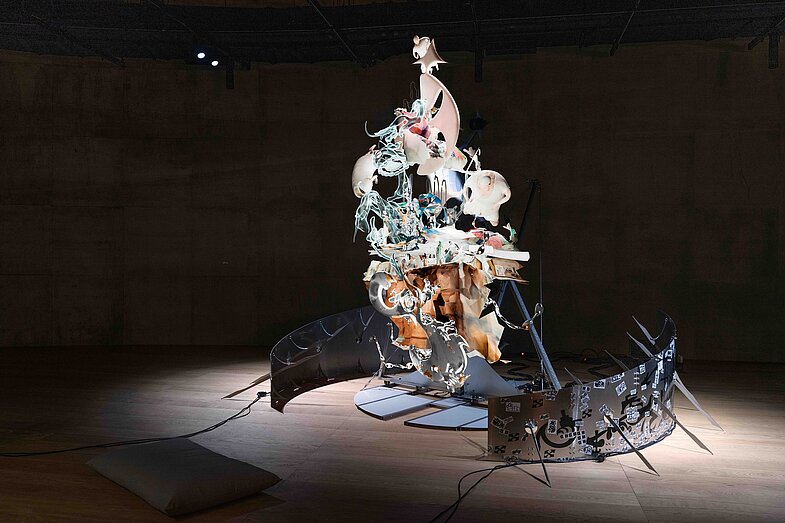
In Shininho, South Korean artist Yaloo launches an 86-year-old K-pop idol on a pirate journey across the Pacific. Inspired by the legendary Zheng Yi Sao, Shin In-ho navigates trade routes once connecting Korea and the United States, turning them into contemporary channels where flows of goods and people merge with flows of data. Piracy is reimagined here not as the pursuit of gold but as the theft of memories for a data center, suggesting that the intangible has become today’s most coveted treasure. The flickering holographic figure shifts between the glow of an advertisement screen and the ghostly presence of someone who never lived. Based on scans of Yaloo’s grandmother and animated with MetaHuman technology, Shin In-ho embodies the transformation of family memory into digital archive. Through her layered collages, Yaloo reflects on the interplay of Asian and American capitalist cultures and on how legacy and identity are reconstructed in the age of transmission, where stories circulate as data, as heritage, as haunting projection.
13 November 2025 - 18 January 2026
Preview / Curator's tour
Friday, 14 November, 5.30 pm
Eröffnung
Friday, 14 November, 7 pm
Artists:
Babak Ahteshamipour
Robin Baumgarten
Mélanie Courtinat
Creative Coding Utrecht
Nathalie Lawhead
OMSK Social Club, Happy New Tears und Jonas Schoeneberg
Sine Özbilge
Alona Rodeh
Janne Schimmel
Dorijan Šiško
Ruben van de Ven
Yaloo
Curators:
Viv Lennert, Lex Rütten
Title graphic: Florida Brand Design
Images works: © the artists
Regular opening hours
Th - Su: 4 - 7 pm
Special opening hours
13 November, 11 am - 8 pm
14 November, 11 am - 10 pm
15 November, 11 am - 8 pm
16 November, 11 am - 7 pm
Winter break
The Künstlerhaus will be closed for the winter break from 22 December 2025 to 4 January 2026.
The exhibition will reopen on 8 January 2026.
Kindly supported by:
Kulturbüro Dortmund, Bergmann Bier, Ministerium für Kunst und Wissenschaft des Landes Nordrhein-Westfalen, NRW KULTURsekretariat, Stadt Dortmund